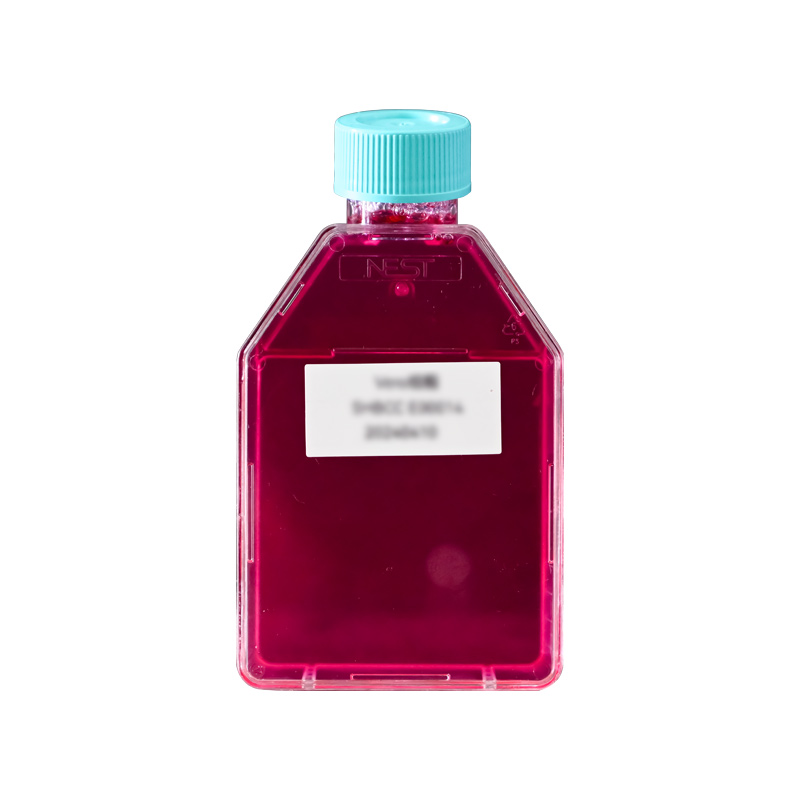人结直肠腺癌细胞,Caco-2 [Caco2],SHMCC E00340返回上一页

人结直肠腺癌细胞,Caco-2 [Caco2],SHMCC E00340
菌株编号:SHMCC E00340
中文名称:人结直肠腺癌细胞,Caco-2 [Caco2],SHMCC E00340
拉丁名称:
价格:¥1700
状态:咨询客服
下载:
产品介绍
平台资源号:
保藏编号:SHMCC E00340
中文名称:人结直肠腺癌细胞,Caco-2 [Caco2],SHMCC E00340
拉丁名称:
模式菌株:
其它保藏中心编号:
来源历史:结肠
收藏时间:
参考用途:动物种类:人;白人组织来源:结肠形态:贴壁生长;细胞形态不均一,有部分含有液泡的巨大细胞性别:男性,72岁细胞描述:人结直肠腺癌细胞Caco-2 [Caco2]分离自直肠原位癌,适于转染。当细胞长满时,可表现出肠上皮细胞分化的特征。Caco-2细胞表达维甲酸结合蛋白I和维甲酸结合蛋白II。每个批次均通过本库支原体检测,结果为阴性。冻存时为P31代。经本库STR检测无误,STR鉴定结果为:Amelogenin: X,CSF1PO: 11,D13S317: 1
生物危害程度:
致病对象:
培养温度:人结直肠腺癌细胞Caco-2完全培养液 配方(100 ml):MEM (Invitrogen,11090081) 77 mlFBS (Gibco) 20 mlGlutamax(invitrogen 35050061) 1 mlNon-essential Amino Acids, 100X (Invitrogen, 11140050) 1 mlSodium Pyruvate 100 mM Solution(invitrogen
需氧类型:气相:空气,95%;二氧化碳,5%。
提供方式:T25培养瓶,干冰冻存管(额外+150元)
保存温度:液氮
培养条件
人结直肠腺癌细胞Caco-2完全培养液 配方(100 ml):MEM (Invitrogen,11090081) 77 mlFBS (Gibco) 20 mlGlutamax(invitrogen 35050061) 1 mlNon-essential Amino Acids, 100X (Invitrogen, 11140050) 1 mlSodium Pyruvate 100 mM Solution(invitrogen 11360070) 1 ml参考传代周期:4-6天参考传代比例:1 : 3备注:传代后细胞贴壁较慢,48h内不要换液;细胞形态不均一,有一些含有液泡的巨大细胞,属正常现象;消化时间5-10 min。参考换液频率:每周2-3次冻存液:完全培养液95%,DMSO 5%气相:空气,95%;二氧化碳,5%。 温度:37摄氏度。
参考文献
Didier ES, et al. Characterization of Encephalitozoon (Septata) intestinailis isolates cultured from nasal mucosa and bronchoalveolar lavage fluids of two AIDS patients. J. Eukaryot. Microbiol. 43: 34-43, 1996. PubMed: 8563708Fogh J, et al. Absence of HeLa cell contamination in 169 cell lines derived from human tumors. J. Natl. Cancer Inst. 58: 209-214, 1977. PubMed: 833871Goodfellow M, et al. One hundred and twenty-seven cultured human tumor cell lines producing tumors in nude mice. J. Natl. Cancer Inst. 59: 221-226, 1977. PubMed: 77210034Adachi A, et al. Productive, persistent infection of human colorectal cell lines with human immunodeficiency virus. J. Virol. 61: 209-213, 1987. PubMed: 3640832Trainer DL, et al. Biological characterization and oncogene expression in human colorectal carcinoma cell lines. Int. J. Cancer 41: 287-296, 1988. PubMed: 3338874Cohen MB, et al. Receptors for Escherichia coli heat stable enterotoxin in human intestine and in a human intestinal cell line (Caco-2). J. Cell. Physiol. 156: 138-144, 1993. PubMed: 8100232Basson MD, et al. Effect of tyrosine kinase inhibition on basal and epidermal growth factor-stimulated human Caco-2 enterocyte sheet migration and proliferation. J. Cell. Physiol. 160: 491-501, 1994. PubMed: 8077287Heinen CD, et al. Microsatellite instability in colorectal adenocarcinoma cell lines that have full-length adenomatous polyposis coli protein. Cancer Res. 55: 4797-4799, 1995. PubMed: 7585508Gilbert T, Rodriguez-Boulan E. Induction of vacuolar apical compartments in the Caco-2 intestinal epithelial cell line. J. Cell Sci. 100: 451-458, 1991. PubMed: 1808199Rigothier MC, et al. A new in vitro model of Entamoeba histolytica adhesion, using the human colon carcinoma cell line Caco-2: scanning electron microscopic study. Infect. Immun. 59: 4142-4146, 1991. PubMed: 1937772Levin MS. Cellular retinol-binding proteins are determinants of retinol uptake and metabolism in stably transfected Caco-2 cells. J. Biol. Chem. 268: 8267-8276, 1993. PubMed: 8463337Trotter PJ, Storch J. Fatty acid esterification during differentiation of the human intestinal cell line Caco-2. J. Biol. Chem. 268: 10017-10023, 1993. PubMed: 8387510Santoro IM, Groden J. Alternative splicing of the APC gene and its association with terminal differentiation. Cancer Res. 57: 488-494, 1997. PubMed: 9012479White LJ, et al. Attachment and entry of recombinant norwalk virus capsids to cultured human and animal cell lines. J. Virol. 70: 6589-6597, 1996. PubMed: 8794293Grindstaff KK, et al. Translational regulation of Na,K-ATPase alpha1 and beta1 polypeptide expression in epithelial cells. J. Biol. Chem. 271: 23211-23221, 1996. PubMed: 8798517

 021-59199805
021-59199805


 集团咨询服务号
集团咨询服务号




